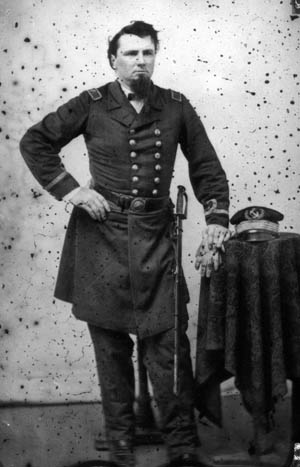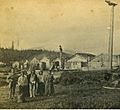Leon Smith (naval commander) facts for kids
Quick facts for kids
Leon Smith
|
|
|---|---|

Leon Smith in uniform
|
|
| Nickname(s) | Lion Smith |
| Born | 1829 Portsmouth, New Hampshire |
| Died | 26 December 1869 (aged 39–40) Wrangell, Alaska |
| Buried |
San Francisco or Houston, Texas
|
| Allegiance | |
| Service/ |
|
| Years of service | 1847–1848 1861–1865 |
| Rank | Captain |
| Commands held | Texas Marine Department |
| Battles/wars | American Civil War |
Leonidas R. Smith (1829 – December 26, 1869) was an American steamboat captain and soldier. During the American Civil War, he volunteered to serve the Confederate States of America. He was named Commander of the Texas Marine Department under General John B. Magruder. Smith took part in most major battles along the Texas coast during the war. The wartime governor of Texas, Francis Lubbock, called him "undoubtedly the ablest Confederate naval commander in the Gulf waters."
Contents
Leon Smith: Steamboat Captain and Civil War Figure
Early Life and Career
Leon Smith was born in Portsmouth, New Hampshire in 1829. He became a sailor at just 13 years old. By the time he was 20, he was in charge of a United States mail steamship called the Pacific. This ship sailed between San Francisco and Panama.
Some records suggest that Smith served in the Texas Navy when Texas was its own country, the Republic of Texas. He met John B. Magruder in the late 1840s while working in shipping on the West Coast. In the 1850s, he sailed in the Gulf of Mexico for the Southern Mail Steamship Company.
Joining the Civil War
In February 1861, Smith was the captain of the steamer General Rusk. He helped transport General John Salmon Ford and his troops to the Rio Grande. They went there to accept the surrender of Union Major Fitz John Porter. After this, Smith, who was not yet officially on either side, agreed to transport the Union troops to New York.
Capturing the Star of the West
In April 1861, Smith and his ship, the General Rusk, volunteered to serve the Confederates in the Gulf of Mexico. On April 18, 1861, Smith and his ship helped Colonel Earl Van Dorn capture the Star of the West. This ship was famous for being the target of the first shots of the Civil War.
Smith used a clever trick to capture the ship. He pulled alongside the Star of the West as if he was transferring "friendly" troops. He told them that more troops and luggage would arrive later. The Confederate troops then boarded the Star of the West and quickly took control of it.
From October 1861 to December 1862, Smith and the General Rusk were under the command of CSN Commander William W. Hunter. On November 7, 1861, Smith helped put out a fire on the ship Royal Yacht and towed it back to port.
The Battle of Galveston
After the Confederates retreated from Galveston in the Battle of Galveston Harbor (1862), General John B. Magruder took command in Texas in November 1862. Magruder knew Smith from before and put him in charge of all the steamers.
Leading the Cottonclads
On Christmas Day 1862, Smith quickly prepared two ships, the CS Bayou City and CS Neptune, for battle. These were called "cottonclads" because they used cotton bales for protection. The cotton bales helped stop small bullets, but not cannon fire. Smith reportedly told a soldier, "None whatsoever... our only chance is to get alongside before they hit us."
Smith's ships also had special boarding devices, similar to those used by the ancient Romans. They faced a much stronger Union fleet with many gunboats.
The attack, known as the Battle of Galveston, was planned for New Year's Eve. Smith's ships were to attack from the sea, while General Magruder attacked from land. Smith was supposed to wait for a signal, but it was delayed. He pulled his ships back, but when he heard the fighting begin, he quickly returned to the harbor.
A Daring Victory
Just before dawn, Smith's forces attacked. The CS Neptune was badly damaged and sank. But Smith, on the CS Bayou City, managed to ram the Harriet Lane. His crew boarded and captured the Union ship. Smith was praised for his bravery and was even mentioned by the Congress of the Confederate States.
Smith then demanded the surrender of the Union fleet. The Union commander, William B. Renshaw, blew up his own ship, the USS Westfield, and died in the explosion. Smith also captured the USS John F. Carr and chased the remaining Union ships. He then captured three more small Union ships with their cargo.
General Magruder tried several times to get Smith an official naval rank, but it never happened.
Commander of Texas Marine Forces
After the battle, Smith remained in charge of all vessels in Texas. General Magruder officially appointed him "Commander, Marine Department of Texas."
Defending Sabine Pass
On September 5, 1863, Smith was inspecting a railroad. On September 8, he was in Beaumont, Texas, when a large Union force attacked up the Sabine River in the Second Battle of Sabine Pass. Smith quickly sent all Confederate troops in Beaumont to reinforce Fort Griffin. He rode to the fort on horseback, arriving just as Union gunboats came into range.
Smith helped defend the fort, which was manned by only 47 troops. The Confederates won a huge victory, capturing two Union gunboats and many Union soldiers, with no losses of their own.
Later, Smith was sent to help defend Indianola, Texas. He commanded several ships, but there were disagreements with the land forces commander. Smith chose to fight defensively. In the summer of 1864, Smith was relieved from duty at his request, as the marine forces were less needed.
After the War
By 1864, Union officials knew Smith well. There were even rumors that he would go to London to buy a fast steamboat for privateering. However, Smith stayed in Texas for a while. In September 1864, he captured a US schooner. In November 1864, he was in Havana, where Union officials noted his presence. He was even held by Spanish authorities for a short time.
Smith later piloted a steamer called the Wren through the Union blockade to Galveston. He reportedly left Texas with other Confederate figures on June 20, 1865.
Life in Alaska
After the war, Smith spent some time in Havana before moving to San Francisco to be with his wife and son. He worked in steamboat operations along the western coast. He tried to use petroleum as fuel for steamers, but this project failed.
After the Alaska Purchase, in 1868, Smith took a small ship filled with goods to Alaska. The ship was wrecked, and most of the cargo was lost. However, a second trip was successful, and Smith settled in Fort Wrangel (now Wrangell, Alaska) with his family. There, he ran a trading post and bowling alley with a partner.
On December 25, 1869, an incident involving a local person led to a conflict with soldiers. The next morning, Smith was shot and later died. His body was sent for burial in San Francisco, and possibly later to Houston, Texas.
Images for kids
-
C.S. Bayou City captures the USS Harriet Lane during the Battle of Galveston.




